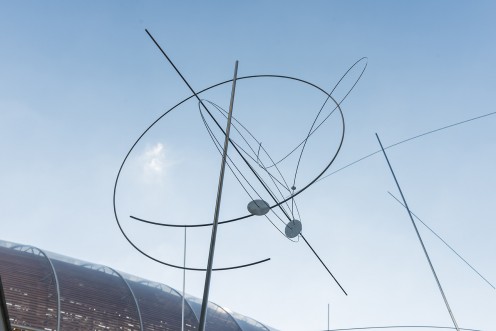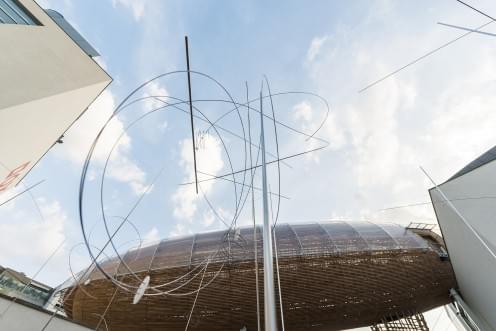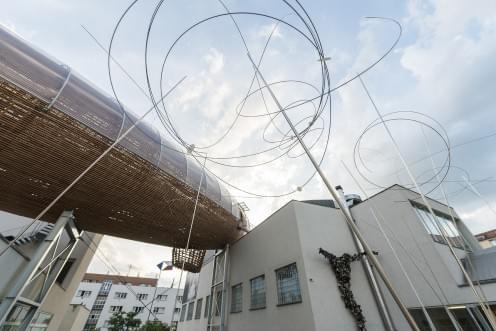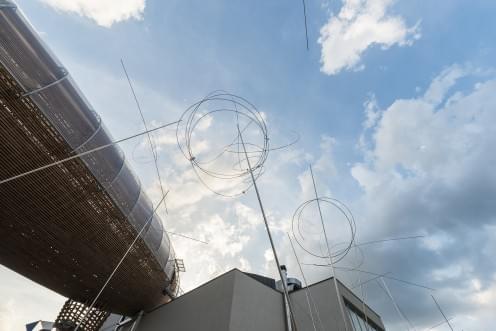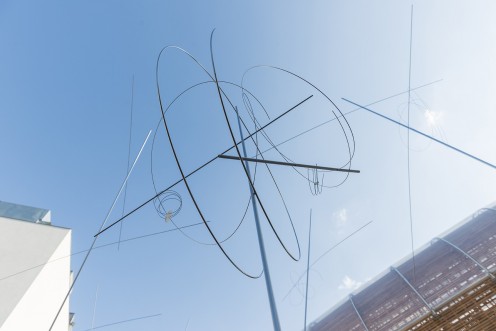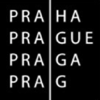Aleš Hnízdil: Genetic Code of Consciousness
8 Jun – 10 Sep 2018
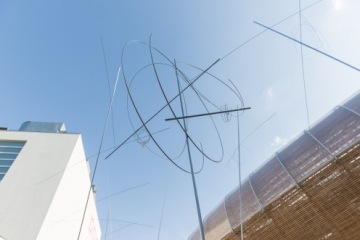
Aleš Hnízdil’s work is based on meditative perception of space. This aspect accompanies his entire body of work and can already be found in his spatial lines from the 1980s created after his graduation from the Sculpture Studio at the Academy of Fine Arts in Prague. They represented emptied silhouettes with hints of human figures confronted by matter and space. A search for internal positions, the perception of man on his emotional level, led Hnízdil to use progressively simpler forms.
He currently works most often with stainless steel and stone – sandstone and alabaster. Steel structures penetrate white chunks of stone, and at other times pieces of paper. While vertical structures are conceived as connecting to infinite space, their cyclical parts evoke the permeation or penetration of consciousness outside the dimension of time.
As part of the Genetic Code of Consciousness exhibition, the DOX Centre terrace features work Aleš Hnízdil has created over the past two years.
Aleš Hnízdil (*1954) studied at the Academy of Fine Arts with Professor Jiří Bradáč and at the GHK Hochschule für Bildende Kunstl in Kassel, Germany with professors W. Kausch and J. Arnold. During the years 1996–1998 he was on staff at the Faculty of Architecture at Technical University of Liberec, and during 1999–2008 at the Faculty of Architecture at Czech Technical. University in Prague. Since 2010 he has been with the Department of Landscape Architecture at the Czech University of Life Sciences Prague. His work is included in collections in the Netherlands, France, Germany, Italy Switzerland, the USA, and the Dutch Antilles.
The path of our consciousness goes up and down, it widens and narrows according to how we think of ourselves in terms of what we are able to understand and what we identify with. We can think of our breath, every intake of breath and every exhalation, as part of empty space and thus identify with it. In the same way we can think of water as part of ourselves and connected to all the things that contain it (water). Thoughts mingle in space and matter, without any time limit. They meet the thoughts of other people, people we actually meet or people who live far away, alive or dead.
An important part of our thinking is how we think of other people and all that surrounds us, whether it is living beings, plants, matter or empty space. We are born and we get to know new things, always new things, and our ideas keep changing. Our ability to identify with the Earth and outer Space is linked to our sensitivity and our ability to feel for others. Our ability to feel sympathy for other people enriches us.
In the emptines surrounding us and the emptiness of outer space, there is a living form of the genetic code of consciousness, we identify with it and it is part of our lives. The genetic code of consciousness is a spiritual equivalent of how particles join to create matter. It affects our thinking as it evolves from¨our birth onwards.
The genetic code of consciousness is independent of our physical presence on Earth. On the other hand, it can be found anywhere new life begins. Our evolving thoughts take us from the past into the future without being limited by present times. This process is not linear, it is a cycle. It is a cycle which does not have a beginning or an end and we are part of it.
Our thinking can be compared to an aperture through which sound and smell, thoughts and images, silence and empathy, the energy we share with everyone and everything, go through. Our thinking can be also compared to a vertical line in that it frees us from the weight of our bodies and enables us to communicate with anyone who’s attuned to our thoughts. We are always in touch with this genetic code of consciousness.
Aleš Hnízdil

